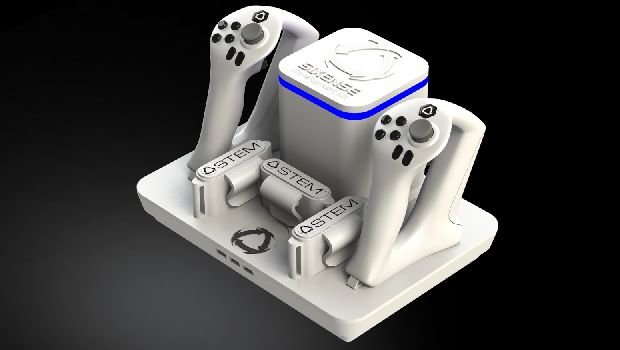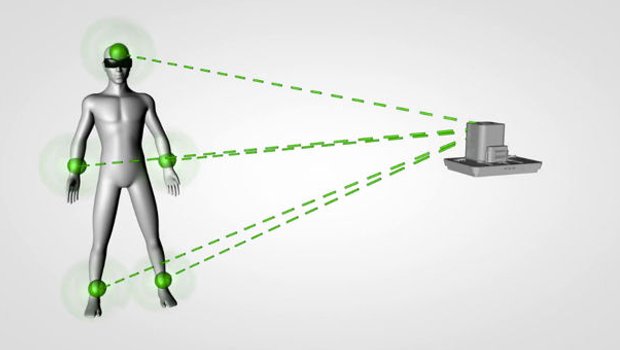One step closer to the Holodeck: Meet the Sixense STEM System
Immersion is a word that gets tossed around a lot. It's one we tend to use when we talk about how believable a game's world is, when its setting and characters seem almost real enough to make us forget that we're interacting with it/them via a $60 chunk of plastic (or, in the case of PC gamers, two $60 chunks of plastic).
That's even easier to forget once you strap on an Oculus Rift and play a game in virtual reality. The Rift is the only thing that's ever made me feel like I was inside a different place or time, not just poking at one through my TV screen. But no matter how cool it is that I can get my head chopped off for fun, or blow up spaceships just by looking at them, the Rift is only a part of the VR puzzle. It's great at tricking my eyes--until I look down at my in-game body (if it even exists) and see a lifeless placeholder that doesn't respond to how I'm actually moving. It kind of, ahem, breaks immersion. And it's exactly the kind of thing that Sixense's STEM System aims to fix.

Recently funded on Kickstarter, the STEM System was designed specifically with virtual reality in mind. The whole setup consists of a wireless base station, two wireless motion controllers, and five "STEM packs"--the little motion tracking modules that provide tracking data to the base station. These can either be inserted into compartments in the wireless controllers, allowing for (holy shit for real this time!) one-to-one tracking, or clipped to your feet, waist, and head to provide motion tracking for your entire body.
"We are living in a world where things are moving so fast," says Amir Ruben, CEO of Sixense Entertainment. "Input devices, not like displays, not like CPUs or GPUs, stayed so far behind for no reason other than [people] got comfortable with the mouse and keyboard, and then with dual analog joysticks. But STEM is an extension of your hands into the digital world."
I mean, of course he'd say that--but Ruben isn't just spewing marketing speak here. When you use your head as a method of input to look around inside a virtual world, controlling the rest of your body's movement with a mouse and keyboard, or even a gamepad, is kind of jarring. The STEM System controllers, however, act sort of like hands. You can reach out with one and see your hand reach out in a game; pull the trigger on the controller, and your virtual fingers will grasp at whatever's in front of you. And because the whole thing is wireless, you don't have to worry about getting tangled up in cords when you're moving your arms around.
Even more exciting are the opportunities created by the additional STEM packs. Let's say you have one in each of the motion controllers, attach one to the Rift, and clip the other two to your legs. With this setup, the STEM System can track your whole body like a poor man's mo-cap station. You could, say, peek around a corner in a game just by leaning in place, without having to press a button, or crouch in real life and have that movement translate to your character in a game.
Sixense is pushing to get peripheral manufacturers on board with its motion tech, too. The idea is that, as new peripherals are developed to support VR, companies can create products with built-in STEM compartments if they so choose, allowing you to slot in a STEM pack and have accurate tracking. Imagine if Disney produced a badass lightsaber that allowed you to shove a STEM pack into its hilt--BAM, there's that super accurate lightsaber game you've always dreamed of (srsly I want a future where we can have legit skill-based dueling tournaments in VR). There's no need for companies to pour resources into developing proprietary motion tracking technology--all they have to do is build a peripheral, which will hopefully entice them to support VR.
Sign up to the GamesRadar+ Newsletter
Weekly digests, tales from the communities you love, and more

Ruben and his team are hedging their bets that the Oculus will be a game-changer, finally transforming virtual reality gaming from a pipe dream into reality. "When I experienced [the Oculus Rift], I said, 'That's it. That's our time, and we need to bring [STEM] to market when the consumer version of Oculus makes it.'" he says. And Sixense is on track to do so: the STEM System is tentatively planned to hit the market in summer 2014, which is when Ruben suspects the consumer version of the Oculus Rift will be available. Clearly his motion tech has generated plenty of interest considering its Kickstarter campaign made nearly three times more than its funding goal.
Say what you will about motion controls, but watching an in-game avatar move its body in relation to your actual movements is undeniably cool--and it'll certainly help increase that fancy immersion thing everyone keeps talking about.
What's Next? is a bi-weekly column exploring the future of gaming tech.
Ryan was once the Executive Editor of GamesRadar, before moving into the world of games development. He worked as a Brand Manager at EA, and then at Bethesda Softworks, before moving to 2K. He briefly went back to EA and is now the Director of Global Marketing Strategy at 2K.



